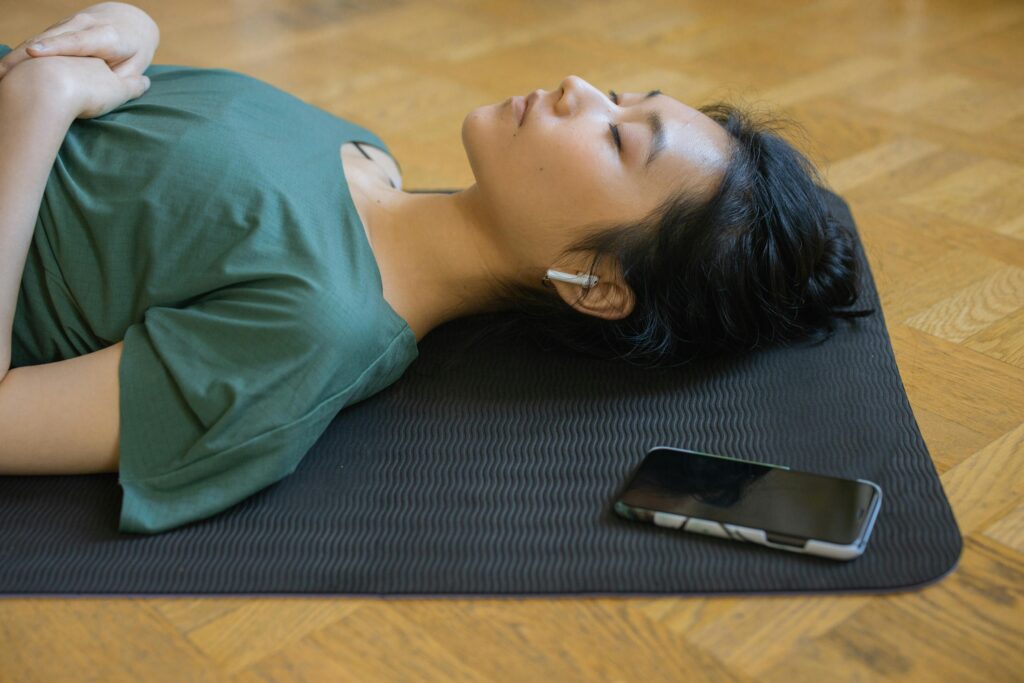Sleep Meditation: A Complete Guide to Better Sleep

Did you know that nearly one-third of adults struggle with insomnia at some point in their lives? Sleep issues are more common than most people realize, and they can have a major impact on overall health and well-being. If you’ve been searching for natural ways to fall asleep faster, stay asleep longer, or simply enjoy more restful nights, sleep meditation could be the solution. This guide will explore what sleep meditation is, how it works, and the many benefits it can offer, helping you move one step closer to the restful, restorative sleep you deserve.
What is Sleep Meditation?
It is a practice that combines meditation techniques specifically designed to promote relaxation and prepare the mind and body for a restful night’s sleep. Unlike traditional meditation practices that may aim to enhance awareness or focus, sleep meditation is intended to reduce mental and physical tension, slowing down the mind’s activity to ease into sleep.
History and Background
Sleep meditation finds its roots in ancient relaxation practices. Techniques such as yoga nidra, a form of “yogic sleep,” were practiced thousands of years ago to reach a deep state of relaxation that borders on sleep. Over time, guided meditations and mindfulness-based approaches have been incorporated into modern sleep routines, supported by science and easily accessible in the form of apps, audio tracks, and podcasts designed to improve sleep quality.
Benefits of Sleep Meditation
Improved Sleep Quality
It works by activating the body’s parasympathetic nervous system, often called the “rest and digest” system, which naturally counters the body’s stress response. By slowing the heart rate, reducing muscle tension, and guiding the mind away from anxious or racing thoughts, sleep meditation helps promote a state of calm that makes it easier to fall asleep. Regular practice of sleep meditation can lead to improved sleep cycles, better quality of REM sleep, and longer periods of uninterrupted rest.

Reduced Stress and Anxiety
Stress and anxiety are two of the most common contributors to sleep issues, and they often create a vicious cycle. When you’re stressed, it’s harder to sleep, and when you’re sleep-deprived, you’re more prone to stress. It can interrupt this cycle by quieting the mind and calming the body. Through deep breathing exercises, progressive muscle relaxation, and guided visualizations, sleep meditation helps ease the mind into a state of peace. Regular meditation practice has even been shown to reduce the production of cortisol, the body’s primary stress hormone, making it a powerful tool for managing anxiety and cultivating inner calm.
Enhanced Overall Well-being
The benefits of it go far beyond just better sleep. Consistently getting high-quality rest can lead to improvements in cognitive function, emotional stability, and immune health. Meditation has been shown to increase levels of melatonin, a hormone that promotes sleep, as well as serotonin, which enhances mood. By incorporating sleep meditation into your nightly routine, you may experience a greater sense of balance, resilience, and overall well-being in your day-to-day life. In addition, sleep meditation offers a sustainable way to improve sleep without the need for medication, contributing to a more holistic approach to wellness.
How to Practice Sleep Meditation: Step-by-Step Guide to Better Sleep
It is a powerful tool that can enhance your overall sleep quality, reduce stress, and improve well-being. But to truly reap its benefits, it’s essential to practice it effectively. This section provides a step-by-step guide to help you get started, along with solutions to common challenges and real-life success stories.
How to Practice Sleep Meditation
Step 1: Prepare Your Environment
The environment you meditate in plays a big role in your experience. Aim to create a space that is calm, quiet, and free from distractions. Dim the lights, reduce noise, and set a comfortable room temperature to create a cozy, sleep-friendly atmosphere. Using soft blankets, essential oils like lavender, and a supportive pillow can help signal to your body that it’s time to wind down and prepare for restful sleep.
Step 2: Choose a Meditation Technique
There are several techniques within It, each with unique benefits. Here are a few popular options:
- Guided Meditation: This method involves listening to a calming voice that leads you through visualizations or relaxation exercises. Guided meditation is great for beginners, as it provides structure and keeps you engaged.
- Mindfulness Meditation: This technique encourages you to focus on the present moment, observing your thoughts and feelings without judgment. Mindfulness can quiet mental chatter, helping you drift into sleep naturally.
- Body Scan: A body scan involves slowly focusing on each part of the body, releasing tension as you go. This practice is incredibly grounding, helping you transition into a state of relaxation.
Experiment with these techniques to see which one suits you best and helps you achieve the deep rest you need.
Step 3: Practice Breathing Exercises
Breathing exercises are essential in sleep meditation, as they encourage relaxation and help center your mind. Start with deep breathing exercises, like the 4-7-8 technique:
- Inhale quietly through your nose for a count of 4.
- Hold your breath for a count of 7.
- Exhale completely through your mouth for a count of 8.
Repeat this cycle several times, allowing the slow, rhythmic breathing to bring your body into a relaxed state.
Step 4: Use Meditation Apps and Resources
To make your meditation practice easier, consider using apps and resources designed for sleep meditation. Some popular options include:
- Calm: Known for its sleep stories and guided sessions, Calm offers a variety of meditations specifically for bedtime.
- Headspace: This app provides sleep-focused meditations and breathing exercises to help you unwind.
- Insight Timer: With thousands of free guided meditations, Insight Timer is ideal for exploring different meditation styles.
These tools offer easy-to-access guidance that makes it simpler to incorporate sleep meditation into your nightly routine.

Common Challenges and Solutions
Even with the best intentions, you may encounter challenges in your sleep meditation practice. Here’s how to overcome them.
Challenge 1: Difficulty Focusing
Solution: If your mind wanders during meditation, remember that it’s natural, especially for beginners. Try focusing on your breathing or a simple mantra like “relax” to center your attention. Guided meditations are also helpful for providing structure and keeping your mind engaged. With regular practice, concentration will improve, making it easier to settle into a peaceful state.
Challenge 2: Restlessness and Discomfort
Solution: If you experience physical discomfort, adjust your position by lying down or using props like pillows and blankets. Progressive muscle relaxation, where you tense and release different muscles, can also help ease restlessness. Remember, comfort is key—there’s no one “correct” position as long as you feel at ease.
Challenge 3: Consistency and Routine
Solution: Building a routine is crucial for reaping the benefits of sleep meditation. Start small, dedicating just five minutes each night, then gradually increase the duration as you feel more comfortable. Set a specific time for meditation to create a habit, and consider using reminders on your phone to keep you on track.
Case Studies and Success Stories
Hearing about others’ experiences can be motivating, especially if you’re new to sleep meditation. Here are a few success stories that highlight the transformative impact of this practice.
Case Study 1: Journey to Better Sleep
A 32-year-old teacher, struggled with chronic insomnia for years. After trying various sleep aids without lasting results, she began practicing guided sleep meditation each night. Within a few weeks, Emily noticed a significant improvement in her ability to fall asleep, and her anxiety levels decreased. Today, Emily relies on sleep meditation as a natural way to unwind, allowing her to enjoy restful sleep without relying on medication.
Case Study 2: Sleep Meditation Enthusiasts
- “I’d tried everything from sleeping pills to white noise, but sleep meditation is the only thing that’s given me consistent results. Now, I fall asleep faster and wake up feeling refreshed.”
- “As a night-shift nurse, my sleep schedule is irregular. Sleep meditation has helped me create a bedtime routine that works no matter the time of day. I can’t imagine sleeping without it now.”


These success stories illustrate how sleep meditation can provide real, sustainable improvements in sleep quality. If you’re ready to try it yourself, start small, be consistent, and embrace the process—you might just find that it is the key to the restful nights you’ve been dreaming of.
By following these steps, overcoming common obstacles, and drawing inspiration from others, sleep meditation can become a powerful tool in your journey toward better sleep and well-being. Start your practice tonight and give yourself the gift of restful, rejuvenating sleep!
Conclusion
Sleep meditation offers a natural, effective approach to achieving better sleep, reducing stress, and enhancing overall well-being. In this guide, we explored the basics of sleep meditation, its history, and the benefits it can bring to your nightly routine. From creating a peaceful environment and choosing the right technique to overcoming common challenges and hearing real success stories, you now have all the tools to get started on your sleep meditation journey.
Ready to take control of your sleep? Try incorporating sleep meditation into your nightly routine, even if it’s just a few minutes each night. Experiment with different techniques, find what feels right for you, and enjoy the calm and relaxation it brings. We’d love to hear from you—share your experiences in the comments, and let us know how it’s impacting your sleep and well-being!
